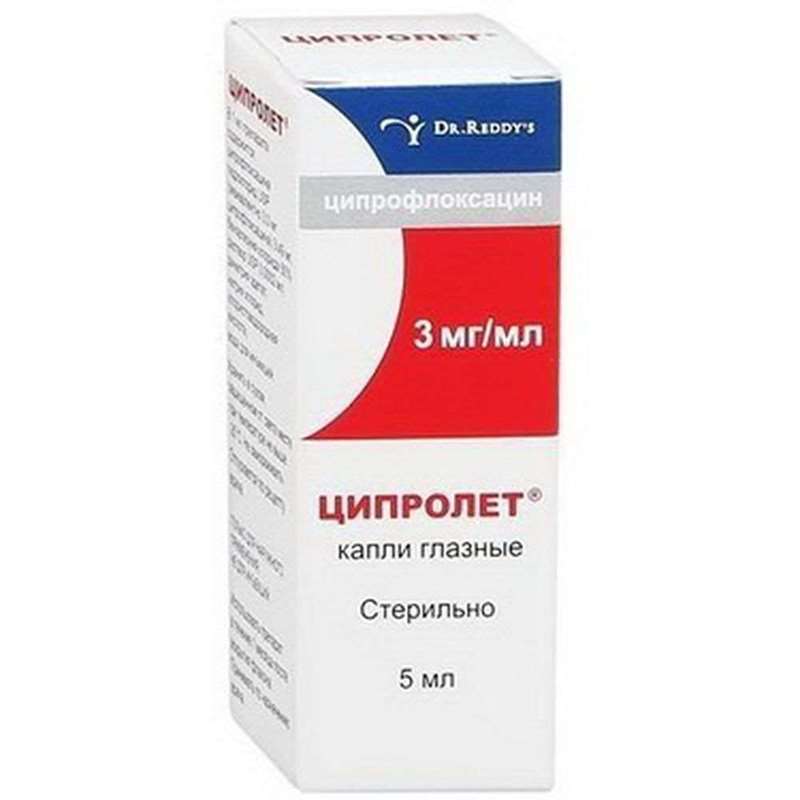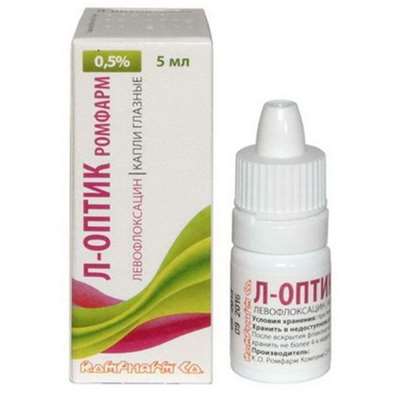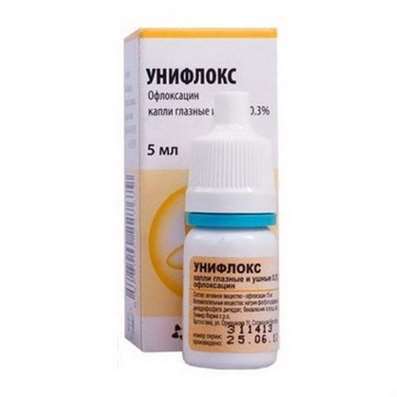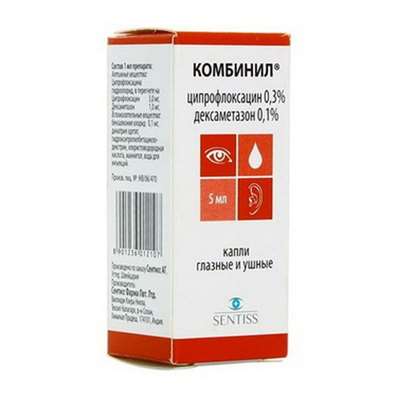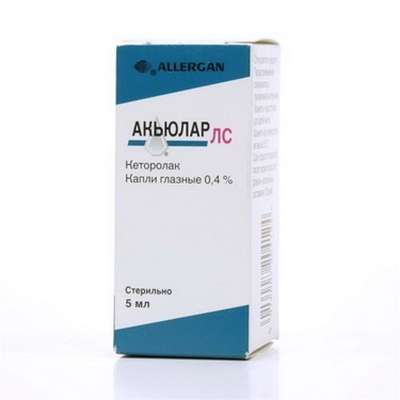Ciprolet eye drops - is an aqueous solution of ciprofloxacin for topical application in ophthalmology. The drug refers to antimicrobial drugs from the group of fluoroquinolones, shows bactericidal action against most gram-negative and gram-positive bacteria, is used to treat bacterial diseases of the eyes (conjunctivitis, keratitis), including those caused by microorganisms resistant to other groups of antibiotics.
A broad-spectrum antimicrobial agent, a derivative of fluoroquinolone. Suppresses bacterial DNA-gyrase (topoisomerases II and IV, responsible for the process of supercoiling the chromosomal DNA around the nuclear RNA, which is necessary for reading the genetic information), violates DNA synthesis, growth and division of bacteria; causes significant morphological changes (including the cell wall and membranes) and the rapid death of the bacterial cell. It acts bacteriocally on gram-negative organisms in the period of rest and division (since it affects not only DNA-gyrase, but also causes lysis of the cell wall), Gram-positive microorganisms are effective only during the fission period. Low toxicity for macroorganism cells is explained by the absence of DNA-gyrase in them.
Against the background of the use of ciprofloxacin, there is no parallel development of resistance to other antibiotics that do not belong to the group of DNA gyrase inhibitors, which makes it highly effective against bacteria that are resistant, for example, to aminoglycosides, penicillins, cephalosporins, tetracyclines and many other antibiotics.
Gram-negative aerobic bacteria are sensitive to ciprofloxacin: enterobacteria (Escherichia coli, Salmonella spp., Shigella spp., Citrobacter spp., Klebsiella spp., Enterobacter spp., Proteus mirabilis, Proteus vulgaris, Serratia marcescens, Hafnia alvei, Edwardsiella tarda, Providencia spp. , Morganella morganii, Vibrio spp., Yersinia spp.); other gram-negative bacteria (Haemophilus spp., Pseudomonas aeruginosa, Moraxella catarrhalis, Aeromonas spp., Pasteurella multocida, Plesiomonas shigelloides, Campylobacter jejuni, Neisseria spp.); Some intracellular pathogens: Legionella pneumophila, Brucella spp., Chlamydia trachomatis, Listeria monocytogenes, Mycobacterium tuberculosis, Mycobacterium kansasii, Corynebacterium diphtheriae; Gram-positive aerobic bacteria: Staphylococcus spp. (Staphylococcus aureus, Staphylococcus haemolyticus, Staphylococcus hominis, Staphylococcus saprophyticus), Streptococcus spp. (Streptococcus pyogenes, Streptococcus agalactiae).
The majority of staphylococci, resistant to methicillin, are resistant to ciprofloxacin. The sensitivity of Streptococcus pneumoniae, Enterococcus faecalis, Mycobacterium avium (located intracellularly) is moderate (their suppression requires high concentrations).
The drug is resistant: Bacteroides fragilis, Pseudomonas cepacia, Pseudomonas maltophilia, Ureaplasma urealyticum, Clostridium difficile, Nocardia asteroides. Not effective against Treponema pallidum.
Resistance develops very slowly, since on the one hand, after the action of ciprofloxacin, there are practically no persistent microorganisms, and on the other hand bacterial cells do not have enzymes that inactivate it.
Pharmacokinetics
Suction
After application of eye drops Cmax ciprofloxacin in plasma is less than 5 ng / ml. The average concentration is below 2.5 ng / ml. After instillation, systemic absorption of the drug is possible.
Excretion
Ciprofloxacin is excreted by the kidneys mainly unchanged (50%) in the form of metabolites (up to 10%), about 15% is excreted through the intestine.
Excreted in breast milk.
Indications:
Local treatment of various infectious diseases of the eye and its appendages caused by bacteria sensitive to the drug:
- Acute conjunctivitis.
- Subacute conjunctivitis.
- Blepharoconjunctivitis.
- Blepharitic.
- Bacterial ulcers of the cornea.
- Bacterial keratitis.
- Bacterial keratoconjunctivitis.
- Chronic dacryocystitis.
- Chronic meibomites.
Preoperative prophylaxis in ophthalmic surgery.
Treatment of postoperative infectious complications.
Treatment and prevention of infectious complications of the eyes after injuries or foreign bodies.
Contraindications:
- Increased sensitivity to ciprofloxacin and other drugs of the quinolone group.
- Viral keratitis.
- Pregnancy.
- Lactation period (breastfeeding).
- Children's age (up to 1 year).
Use with caution in patients:
- A cerebral vascular disease.
- With violation of cerebral circulation.
- With convulsive syndrome.
Special instructions:
Eye drops can only be used topically, do not inject the drug subconjunctivally or into the anterior chamber of the eye.
When using eye drops Ciprolet and other ophthalmic solutions, the interval between their administration should be at least 5 minutes.
During the treatment with the drug, contact lenses are not recommended.
Impact on the ability to drive vehicles and manage mechanisms
Patients who temporarily lose visual clarity after application are not recommended immediately after instillation of the drug to drive a car or work with complex equipment, or with any complicated equipment that requires clear vision.
Side effects:
From the side of the organ of vision: itching, burning, mild soreness and congestion hyperemia; rarely - eyelid swelling, photophobia, lacrimation, sensation of foreign body in the eyes, decreased visual acuity, appearance of white crystalline precipitate in patients with corneal ulcer, keratitis, keratopathy, corneal infiltration.
Other: allergic reactions, nausea; rarely - an unpleasant aftertaste in the mouth immediately after instillation, the development of superinfection.
Drug Interactions:
When combined with the drug Ciprolet with other antimicrobial agents (beta-lactam antibiotics, aminoglycosides, clindamycin, metronidazole), synergy is usually observed. Ciprolet can be successfully used in combination with azlocillin and ceftazidime in infections caused by Pseudomonas spp .; with mezlocillin, azlocillin and other beta-lactam antibiotics - with streptococcal infections; with isoxazole penicillins and vancomycin - with staphylococcal infections; with metronidazole and clindamycin - with anaerobic infections.
Pharmaceutical interaction
The solution of ciprofloxacin is pharmaceutically incompatible with drugs with pH 3-4 that are physically or chemically unstable.
Suggested Use:
Apply locally.
With mild and moderately severe infection, 1-2 drops are injected into the conjunctival sac of the affected eye every 4 hours, with severe infection - 2 drops every hour. After the condition is improved, the dose and frequency of instillations are reduced.
With a bacterial ulcer, the cornea is prescribed 1 drop every 15 minutes for 6 hours, then 1 drop every 30 minutes during waking hours; on day 2 - 1 drop every hour during waking hours; from 3 to 14 days - 1 drop every 4 hours during waking hours. If after 14 days of therapy epithelization has not occurred, the treatment can be continued.
Packaging:
- Comes in original packaging. Item is brand new and unopened.
Storage:
- Keep away from direct sunlight.
- Keep locked and away from children.
- Store in dry place at room temperature.
- Do not exceed storage temperature higher than 25 C
Important notice- the outer box design may vary before prior notice!

 Cart
Cart
